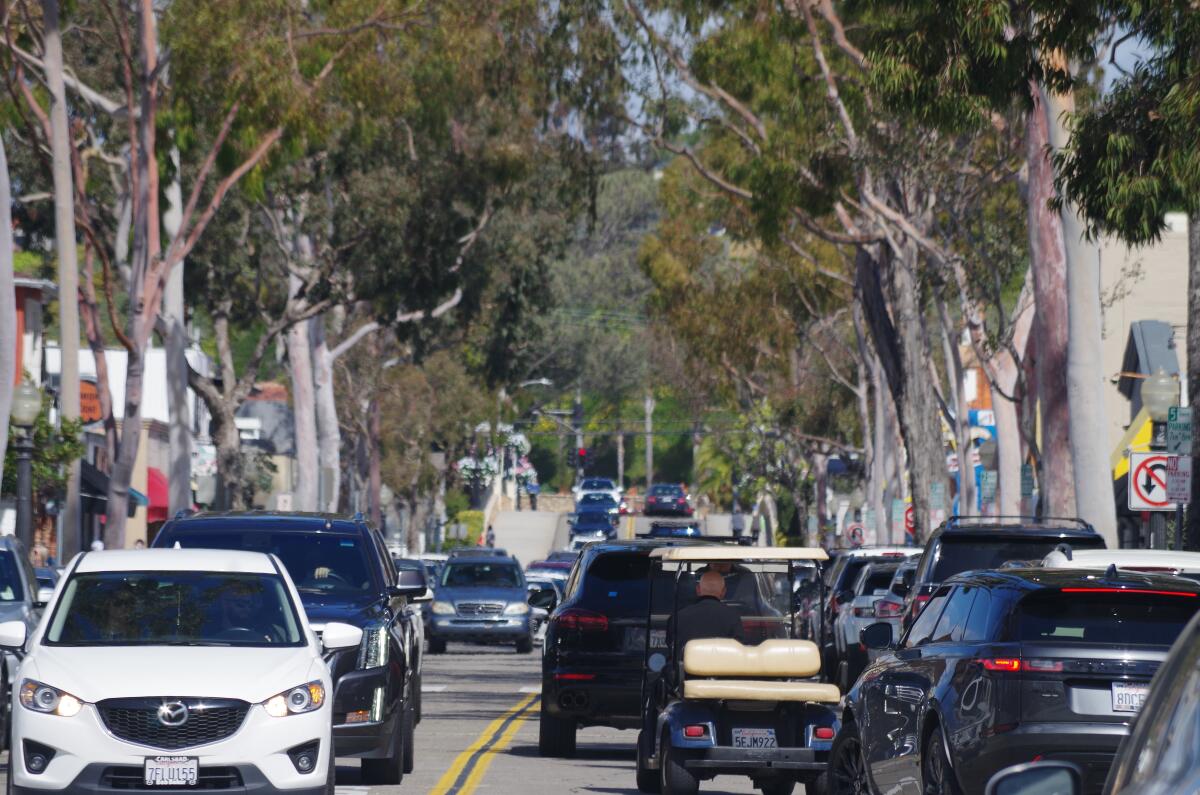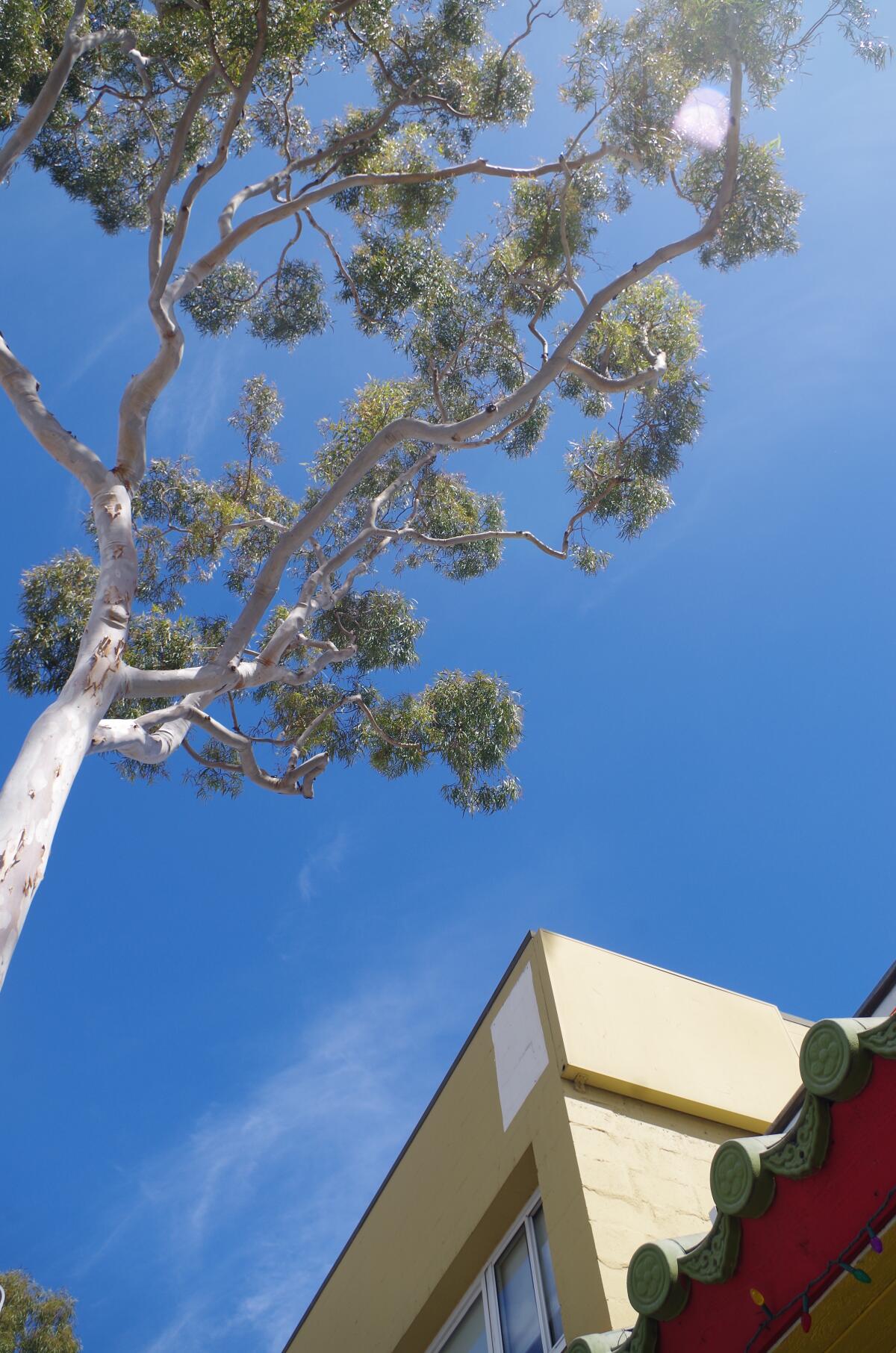10 Balboa Island trees should be removed within a year, Newport Beach arborist says, though residents object

- Share via
Five arborists recently evaluated the trees of Balboa Island’s Marine Avenue, and their recommendations fall on a spectrum.
The worst-case scenario from one of two arborists working for the city of Newport Beach is that 27 of the 42 towering mature eucalyptus trees need to come out because they show damage and decay. Another says at least 10 should be removed within a year. One is already dead, with skeletal brown branches.
But some residents have hired their own experts and dispute the city’s conclusions.
The fate of the public trees is up to the City Council and staff, and after more than two hours of discussion Tuesday evening, the council didn’t make any decisions. But staff says planned upgrades to aging pavement on Marine Avenue could mean the trees would lose their support system.
Many neighbors, however, say the trees are part of what makes the tight-knit island charming.
The towering mature eucalyptus trees that line Marine Avenue on Newport Beach’s Balboa Island could come down if the city makes extensive infrastructure upgrades in the area, and a group of residents wants to preserve the trees as part of the island’s history.
Councilman Kevin Muldoon blasted the process so far as opaque.
“Staff has articulated in no uncertain terms they have the ability to cut down these trees without anybody able to stop them, and I’m trying to stop them,” he said. “This study session allows you, the residents, to say we don’t trust the city staff, and your gut is right on this.”
Resident Randy Black said a stroll along tree-shaded Marine to get a Balboa Bar ice cream treat or frozen banana is “the iconic experience of Newport Beach,” made famous by Newport-set TV shows like “Arrested Development.”
But Walt Warriner, a city-contracted arborist, stood by his conclusion that 27 trees should be cut down.
About half of the Marine trees are lemon-scented gums, a type of eucalyptus. He said eucalyptuses as a whole are dicey, with their naturally asymmetrical crowns, leaning trunks and small root mass. Condensed over the two-block area, the risk is heightened.
“I’ve had tens of thousands of eucalyptus trees under my care. I’ve dissected thousands of eucalyptus trees,” Warriner said. “What you see above ground with those eucalyptus trees is probably 50 times greater than what’s underground holding that tree in ground.”
The city’s staff arborist, Kevin Pekar, generally agreed with Warriner’s recommendation. He triaged the 10 worst specimens — “the trees that I feel would fall completely over”— and suggested they come out this fiscal year, which runs through June. The 17 others should come out in two or three years, he said. All the trees would be replaced with young eucalyptuses standing about 8 to 10 feet tall.
Pekar said the trees aren’t even the street’s originals. Marine Avenue, the island’s Rockwellian village of mom-and-pop shops and cafes, saw its first trees in the 1920s, not long after developers dredged the island out of a shoal.
“Considering the location, a lot of these older trees are reaching the end of their typical life span” of 50 to 60 years, he said.

Balboa Island resident Jodi Boles co-founded the Balboa Island Preservation Assn. to protect Marine Avenue and particularly the trees. The group has retained three arborists and at least three attorneys in its quest.
“We believe, the community believes, all objectivity of Marine Avenue trees from [the] Public Works [Department] has gone out the window,” Boles said.
One of the preservation group’s arborists, Greg Applegate, said only three of the trees should come down.
Another, Mark Porter, said Warriner’s report offered limited mitigation measures, used speculative language and didn’t mention the most advanced risk assessment techniques, such as sonic tomography to detect hidden decay or ground-penetrating radar to map roots.
“The report condemns the trees without testing,” Porter said. “Think of putting a loved one on hospice without an X-ray, lab test, an MRI or without proper clinical diagnosis.”
Boles called Warriner’s report an inaccurate “hit piece to get rid of the trees.”
Warriner said the costs of advanced tests are greater than the monetary value of the trees.
He said he will stand up for trees but also say when they need to come down.
“I am not a hit man,” he said. “I’m an arborist.”
Public Works Director Dave Webb said the face lift that could uproot the trees is at least three to five years away. It will be vetted by the Parks, Beaches & Recreation Commission and the City Council and is independent of a review of the trees’ current health.
The parks commission, which handles public tree removal and replanting requests, has already agreed to extract the dead tree in the 300 block of Marine Avenue, outside Abrams Coastal Properties. On Sept. 3, the commission will consider removal of the nine other trees the city deemed in the worst condition.
Councilwoman Joy Brenner, a former parks commission chairwoman, said her fellow commissioners often recommended tree removal because they posed hazards. But the City Council didn’t always agree, as was the case in the 1980s with trees on Poppy Avenue in Corona del Mar, she said. The desert gums, also a type of eucalyptus, were known to push up the sidewalk. Thirty-six of them finally were removed in 2015. Saplings now line Poppy where the 80-year-old trees once stood.
Had the council at the time replaced distressed trees as the need arose, the mass cutting wouldn’t have happened, she suggested.
Brenner said feedback on the Marine Avenue trees, fueled by social media, has at times been insulting.
“What I see happening is what’s happening in our country, where there is eagerness to condemn and vilify and not work together,” she said.
All the latest on Orange County from Orange County.
Get our free TimesOC newsletter.
You may occasionally receive promotional content from the Daily Pilot.




